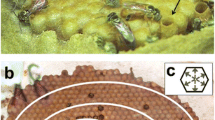Summary:
In stingless bees brood cells are sequentially filled with liquid larval food (mass-provisioning), upon which the queen lays an egg. Thereafter the cell is closed by a worker. This study showed that during these processes workers of Melipona subnitida regularly laid eggs that served as food for the queen. Occasionally cells were oviposited in and immediately closed by a worker. These cells always rendered males. Some of these reproductive workers were seen to lay a trophic egg as well. Cells which were exclusively oviposited in by the physogastric queen gave rise to workers and queens only. In one colony it could be verified that three workers alone, which differed in age by one day, laid 15 male-producing eggs within a period of two successive weeks. Among them the number of ovipositions was positively related to the order in which workers eclosed - the oldest worker laying most eggs - and inversely related to the number of times they closed cells oviposited in exclusively by the queen. Apparently the physogastric queen was not able to stop certain workers from reproducing. We therefore conclude that some workers in M. subnitida temporarily dominated their queens in egg-laying.
Similar content being viewed by others
Author information
Authors and Affiliations
Additional information
Received 2 April 1998; revised 9 March 1999; accepted 16 March 1999.
Rights and permissions
About this article
Cite this article
Koedam, D., Contrera, F. & Imperatriz-Fonseca, V. Clustered male production by workers in the stingless bee Melipona subnitida Ducke (Apidae, Meliponinae). Insectes soc. 46, 387–391 (1999). https://doi.org/10.1007/s000400050161
Issue Date:
DOI: https://doi.org/10.1007/s000400050161




